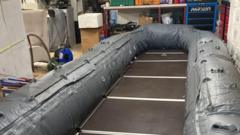
A Genesee County business park is caught up in a data center debate. Representatives of two different projects have proposed building data centers at the Science Technology and Advanced Manufacturing Park, or STAMP, in the Town of Alabama. Each project is valued at over $3 billion.
But a data center would represent a departure from the type of tenants economic development officials have targeted for STAMP, a business park that sits between the Buffalo and Rochester regions. Data centers typically come with big-dollar investments but generate relatively few jobs and little spinoff development. They also are significant consumers of power.
The Genesee County Economic Development Center, which owns STAMP, is considering approving development of a data center at a time when one of the park’s two tenants, Plug Power, has paused construction of its facility , including a crucial – and costly – electrical substation that will be needed by other companies in the park. A truck drives by a sign for the STAMP site. The GCEDC’s board hasn’t made a final decision on approving a data center at STAMP.
Earlier this month, the board voted to let one of the proposals, represented by the real estate firm JLL, to move on next steps, including an access agreement allowing for additional studies of the land, and for a state environmental review to begin. The backer of a competing proposal, Washington, D.C.
-based PRP Real Estate Investment, argues that it has not received equal consideration from the GCEDC, which owns STAMP. PRP was notified that its proposal will be part of the agenda the GCEDC’s STAMP committee meeting and the regular board meeting next week, said Tom Wasko, PRP’s director of acquisitions. As of Friday morning, the GCEDC had not yet posted online the agenda for those meetings.
The data center debate comes at a time when STAMP has generated other headlines: • Plug Power, the park’s first tenant, has indefinitely halted construction of a "green hydrogen" facility valued at $678 million, amid financial struggles at the company. Plug Power was also supposed to fund construction of the electrical substation, which could cost upward of $30 million. • Edwards Vacuum is moving ahead with building a $319 million plant that will make dry pumps, to support the semiconductor industry.
• STAMP is facing criticism, including from the Tonawanda Seneca Nation, over detrimental effects of infrastructure development on the environment and wildlife. Those concerns center on water and wastewater pipelines to serve the park. Chicago-based JLL has not disclosed the developer of the data center project it represents, known as Project Hydroscale.
The $3.8 billion project would consist of two, two-story, 450,000-square-foot facilities on 45 acres, and employ 60 people, according to documents filed with the GCEDC. PRP said its proposal, called Project Rampart, is valued at $3.
3 billion. The project would consist of three single-story buildings, each 250,000 square feet in size, on 100 acres, and employ 105 people. PRP would pay $30 million for the land.
The GCEDC's board and staff are considering both proposals, said chairman Peter Zeliff, in a statement. Zeliff noted the GCEDC has aimed to attract companies in the advanced manufacturing, renewable energy and semiconductor sectors at STAMP. "We also need to be mindful of continuing to build out infrastructure at the site, including the electric substation which is critical aspect of bringing these companies to STAMP," he said.
Plug Power has paused construction of its green hydrogen facility at STAMP, shown in August. Zeliff said when the GCEDC assesses projects such as data centers, the agency "considers a number of different factors including assessing the number of good-paying jobs in the local community created, the footprint of this type of project and its electric and water needs with the intent of minimizing its impacts so we can further our continued efforts in bringing to STAMP the types of companies that can create significant job and economic growth that we are targeting for at STAMP." Projects in the advanced manufacturing, renewable energy and semiconductor sectors "often require a much larger footprint and can have significant infrastructure needs which must be kept in mind when evaluating applications for projects such as data centers.
" “In this instance, a decision will be ultimately predicated on whether proposed projects fulfill our vision for STAMP," Zeliff said. "We look forward to working with both companies as well as our stakeholders as the GCEDC board considers these applications.” The Edwards Vacuum plant at the STAMP site, shown under construction in August.
PRP has offered to pay $25 million to $30 million to complete construction of an electrical substation to serve STAMP tenants, rather than have the agency rely on state funding to complete the project, Wasko said. Plug Power was responsible for funding construction of the substation, which is considered essential to support other tenants, such as Edwards Vacuum. As for the economic impact of data centers, Wasko said PRP's complex would employ more people at STAMP than Plug Power, which has estimated employing 89 people at its location when fully built.
Wasko also pointed to a case study of an Indiana business park, where Meta established a data center. Within the next nine months, three other projects committed to the site because they viewed Meta's investment as a vote of confidence, he said. "We see the same thing happening at STAMP," Wasko said.
Not all data centers have generated such impact. Yahoo's data centers in Niagara County have expanded over time but have not been a big source of employment or spinoff activity. PRP's project is also considering using a "closed loop" cooling system for its project that would minimize the amount of water its data center complex would require.
Wasko contends GCEDC hasn't been as receptive to PRP's proposal as it has to Project Hydroscale's. "They can't seem to understand that having two proposals and considering them both at the same time is going give them the best outcome," said Wasko, who grew up in Amherst and Clarence. "They've really done a lot to try to discourage us from moving along.
" The GCEDC declined to comment on Wasko's remarks. Wasko said PRP's proposal to use 100 acres – compared to 45 acres for Project Hydroscale – would enable PRP to develop single-story facilities, which he said are more cost-effective to build and would be lower profile in their rural surroundings. PRP has developed projects around the country including "hyperscale" or cloud data centers, which are operated by a single user and support large internet companies.
Customers lease or buy the facilities from PRP. Wasko said a customer probably wouldn't commit to PRP's proposed complex at STAMP until PRP has full control of a site. But he said PRP has received interest from a couple of companies, one of whom considered another Western New York site that didn't work out.
Wasko said he hopes the GCEDC board votes to advance PRP's proposal to the next steps, just as Project Hydroscale's was. "I'm just looking forward to moving along," he said. "We did a tremendous amount of work in a pretty short time, in terms of the studies that we've done to date.
We're just excited to keep it going." Matt Glynn The business news you need Get the latest local business news delivered FREE to your inbox weekly. Reporter {{description}} Email notifications are only sent once a day, and only if there are new matching items.
.














